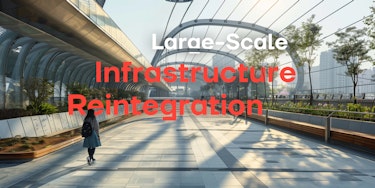Large-scale infrastructure such as highways, bridges, railways, and industrial zones are fundamental to the functioning of modern cities. While these systems are necessary for transportation, logistics, and economic growth, they often come with an unintended consequence: the fragmentation of urban landscapes. Infrastructure can act as physical barriers, isolating neighbourhoods, disrupting social cohesion, and cutting off access to essential resources.
Reintegration strategies aim to address this divide, creating opportunities to reconnect communities, enhance environmental sustainability, and reimagine how cities interact with their infrastructure. As cities continue to grow, architects and planners are rethinking infrastructure to ensure it not only supports urban functionality but also contributes positively to the urban fabric.
This article explores several strategies that can guide the reintegration of large-scale infrastructure projects, focusing on innovative design solutions, sustainable practices, and the use of visual storytelling to communicate these transformations.
Reconnecting Fragmented Communities
Physical Connectivity: Large-scale infrastructure, especially highways and railways, often divides communities. Strategies to physically reconnect these areas are critical for restoring social cohesion and access to resources.
Green Bridges and Ecological Corridors: These bridges not only provide pedestrian and vehicular passage across infrastructure but also offer green spaces that help reintegrate fragmented ecosystems.
Underpasses and Tunnels: Safe, well-designed underpasses can allow pedestrians and cyclists to traverse busy infrastructure without being exposed to traffic hazards, thus reconnecting previously divided neighbourhoods.
Urban Integration Projects: The Ecoduct in the Netherlands, which bridges fragmented habitats and communities over the A50 highway, is a notable example of design thinking focused on both urban and ecological reintegration.
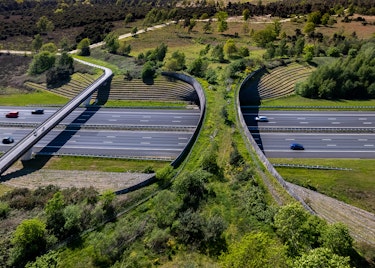
Credit: The UNESCO Courier
Incorporating Sustainability into Infrastructure Projects
Renewable Energy Integration: Incorporating renewable energy solutions into infrastructure design ensures that these large projects contribute to a city’s sustainability goals.
Solar-Powered Roads: Technologies like solar roadways can turn infrastructure itself into energy-generating entities, as seen in the U.S. Solar Roadways project.
Wind Turbines and Energy Harvesting: Integrating small-scale wind turbines or kinetic energy systems in high-traffic areas to harness energy from vehicular movement or pedestrian activity.
Greenway Development: Developing linear parks or greenways alongside infrastructure like railways can reconnect fragmented ecosystems and provide much-needed recreational areas for residents.
Urban Cooling and Air Quality: These green corridors can help reduce urban heat islands, improve air quality, and provide ecological continuity within the cityscape.
Sustainable Material Usage: Projects like the Bosco Verticale in Milan utilize sustainable materials and green building techniques to create self-sustaining infrastructures that also serve as community spaces.
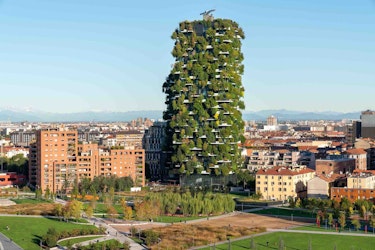
Credit: Stefano Boeri Architetti
Transforming Infrastructure into Public Spaces
Repurposing Infrastructure: Many cities are finding creative ways to transform unused or underutilized infrastructure into public spaces, contributing to urban vibrancy.
High Line Park in New York: An elevated railway track was reimagined into a popular public park, blending infrastructure with public space and contributing to the surrounding community’s revitalization.
The Bentway in Toronto: The space beneath an overpass was repurposed into a pedestrian walkway and cultural hub, creating a multifunctional public area that brought new life to a previously neglected space.
Temporary Installations: The use of art, pop-up events, and temporary structures around or within infrastructure can encourage public engagement and turn divisive spaces into social and cultural hotspots.
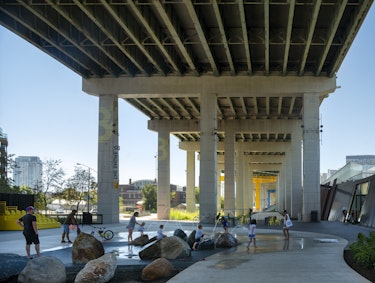
Credit: ArchDaily
Adaptive Reuse of Aging Infrastructure
Repurposing Outdated Structures: Rather than demolishing old or obsolete infrastructure, adaptive reuse provides an opportunity to repurpose these elements for new uses, maintaining historical significance while giving them new purpose.
Rail-to-Trail Conversions: The transformation of disused railways into public parks and pedestrian trails is a prime example of adaptive reuse, with notable projects such as the Promenade Plantée in Paris and the High Line in New York.
Factory Lofts and Cultural Centers: Former industrial zones, like old factories and warehouses, are being transformed into commercial spaces, art galleries, or residential units, adding economic and cultural value to previously overlooked areas.
Maintaining Heritage While Enhancing Utility: The Zeitz Museum of Contemporary Art Africa in Cape Town, housed in a repurposed grain silo, preserves the historical significance of the building while transforming it into a contemporary cultural landmark.

Credit: MoMAA | Affordable Art Gallery & Lifestyle
Embracing Digital and Smart Infrastructure
Smart City Integration: As cities evolve, digital technology is becoming a key element of infrastructure reintegration. Smart infrastructure helps optimize urban systems, making them more responsive and sustainable.
Smart Grids and Energy Efficiency: Smart grids can manage energy flow more effectively, distributing renewable energy across urban areas and integrating it into large-scale infrastructure projects.
IoT-Enhanced Transportation: Smart transportation systems can monitor and adjust traffic patterns in real-time, reducing congestion and improving urban mobility.
Data-Driven Infrastructure Design: In Barcelona, smart infrastructure solutions have been implemented to manage energy consumption, improve waste management, and optimize traffic systems, enhancing both efficiency and sustainability.
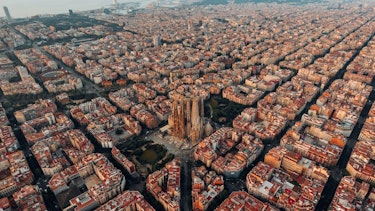
Credit: Smart CRE
Reintegrating large-scale infrastructure into the urban fabric is a complex and multifaceted process that requires thoughtful design, sustainability considerations, and innovative thinking. It’s not just about reconnecting communities physically but also about reimagining how infrastructure interacts with the environment and the people who live around it.
